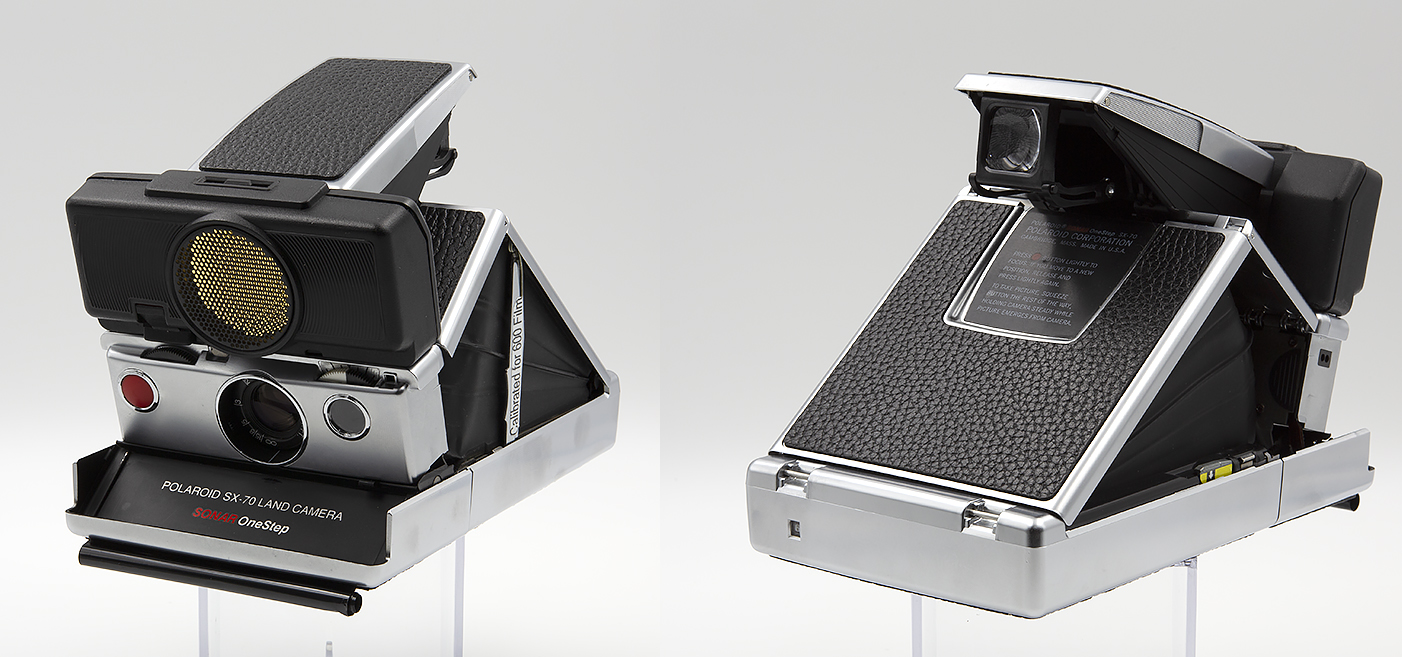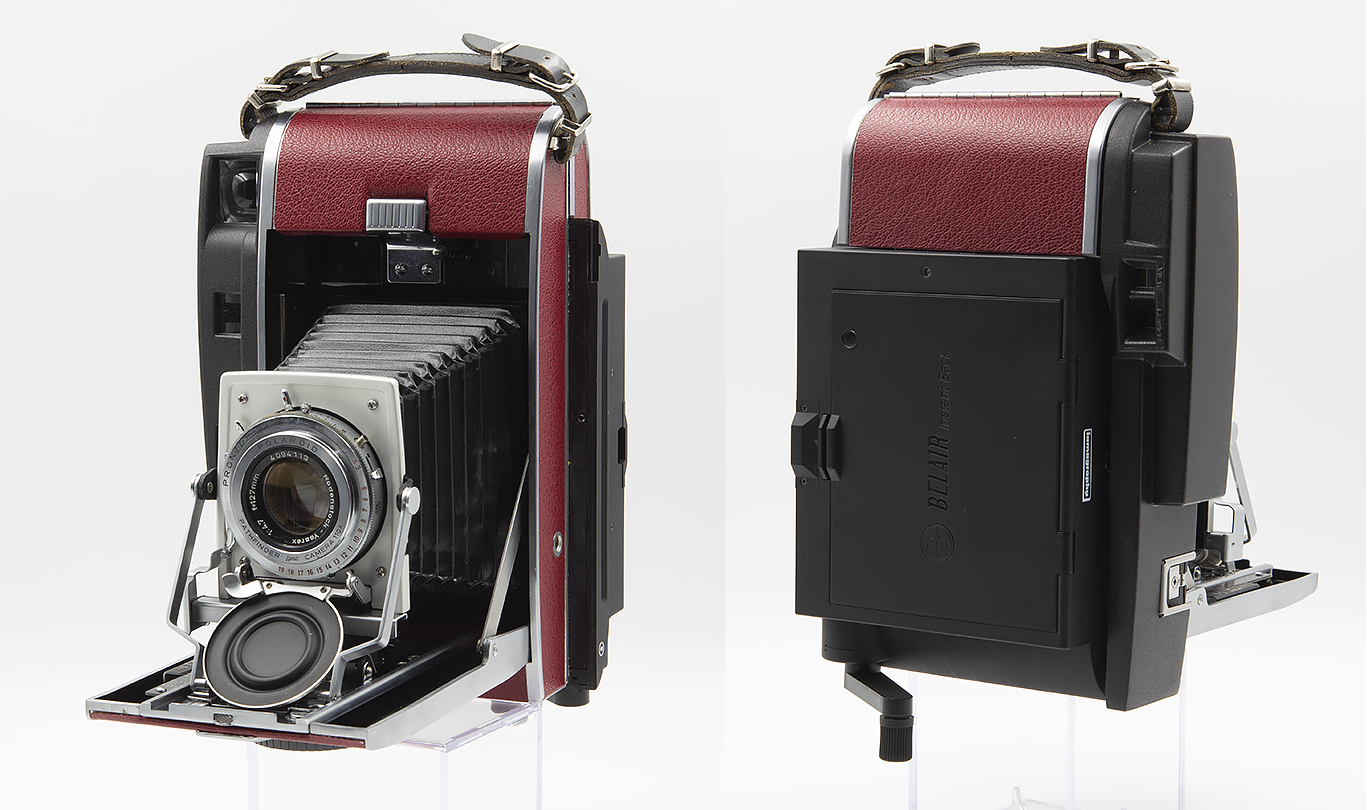Bruce Varner Photography BruceVarner.com



SX-70 Camera Comparisons
--Testing Which Camera To Shoot When Exposing Polaroid Originals Film--
Focus Pre-Testing
In dealing with SX-70 cameras, I have found
that the correct focus is often different from that indicated on either the
lens (On those cameras that have measurements) or using a
split-prism through the view finder. So, I conducted a pre-test on these
SX-70's to ensure I know at what settings the camera actually achieves its
best focus.
I can then note any discrepancy and take that into consideration in future
focusing of that particular camera.
The basic focusing test I conducted with each of these cameras consists of a
minimum 2 shots:
1) Close-focus.
Place the subject at a measured 3'. I have a 48" ruler which I lay flat
near camera level, in front of the
tri-pod mounted camera. I place a vertically mounted
stick at the center point of the ruler and place the camera exactly at 3' from the
stick. I then focus on the stick until the split-screen is aligned.
If the camera does not have a split-screen, I focus manually on the stick
&/or set any focus ring on the lens to exactly the 3' mark and take a
correctly exposed image. For this distance, if the camera is a Sonar
model, I replace the stick with something large and textured so that the
sonar signal will focus on that spot and not search around for the wrong
distance.
2) Medium focus. Place the subject at a measured 10'. I pick a spot that
has subject matter at all distances, from close-up to infinity. I
place the camera at exactly 10'. Focus the camera as
described in shot 1 on the stick and take a correctly exposed image.
I do not take shots at other distances for most cameras. The changes were extrapolated using the results from just these two shots.
After the images have fully developed, I look closely at each using a magnifying glass to find the clearest point of focus in the image. I measure that distance and in the future make allowances of that amount in focus when capturing images at close or medium distances, for that camera.
Focus Pre-Test Results
#1 Polaroid SX-70, Alpha 1, Model 2 –
[Polaroid Original SX-70 Color Film]
Close Focus 3’:
Result: With split image
aligned, lens distance marks indicated just less than 5'.
Sharpest point was 3’ 6”.
10’ Focus:
Result: With split image
aligned, lens marks indicated infinity!.
Sharpest point was 18’+
#2 Polaroid SX-70, Model 1 – 2nd
Shot – [Polaroid Original SX-70 Color Film]
Close Focus 3’:
Result: With split image aligned, sharpest point was 4’
Result: With split image aligned, sharpest point was 18’+
#3 Polaroid SX-70,
Sonar – 2nd Shot – [Polaroid Original 600 Color Film]
Close Focus 3’:
Result: Sonar focus on stick @
3’. Actual focus was 3’.
10’
Focus:
Result: Sonar focus on stick @ 10’.
Actual focus was 10’+
Close Focus 3’
Result: With split image aligned, lens mark matched 10'. Sharpest point was 10’+
I should have known after obtaining these initial focusing results that I was in store for a hard time! The tested best focus distances did not always work out as accurate, everytime for every shot. Post testing, during interaction with Matt Widmann of 2nd Shot, I learned several details that help explain the issues that surfaced. See page 3 in the conclusions section for more details.
Testing Breakdown
I used new film for all the
tests. I tried to take images of the same subject, in the same or
similar light, with each camera. I did not set the exposure for
each camera and each shot to the exact same setting. Individual
cameras are different, and require slightly different settings. I
made adjustments to each camera so that the end result images would be
exposed as closely as possible to each other. I did not include
any obviously bad chemicialy developed shot. I come to expect
those. I just discard and re-shoot that scene. Every shot was made
from a tripod if possible, to limit human error from the sharpness
equation. I also have at least one comparison shot that
purposefully contains subject matter at various distances from the
cameras. This was done so that you can tell whether the image is
not sharp because of mis-focus or just not sharp. I have provided a simple overview
of each camera. Much more "in detail" overviews may be obtained
from many sources for each camera if you want that additional
information. I provide my
thoughts. Finally, I provide the images for you to
compare and make your own decision on those factors that are important
to you. You may not observe a significent difference in finished
images between some of the cameras. In such a case your decision
may
come down to reliability, the ability in some cameras to use
faster speed film, or cost.
CAMERAS USED:

Polaroid SX-70,
Alpha 1, Model 2.
eBay purchase for $95. I purchased
this particular camera because it was functional, and was accompanied by
the original purchase paperwork. It is reasonably
functional. Uses Polaroid Originals SX-70, 160 ASA speed film.
"Reasonably functional" means the camera loads, exposes, and ejects the
film most of the time. Internal focus screen shows some dirt and exposure meter
is off (40
year old SX-70's have much crud on the internal light meter that can prevent accurate metering). This also further limits the latitude of
exposure setting. This is the control camera. Not
reburbished. Just protected since new sufficiently so that it
still functions.

Polaroid SX-70, Model 1, 2nd Shot Rebuild.
Originally my camera. A garage sale find for $35. Was
shipped to 2nd Shot for refurbish. Cost $135 + shipping in early
2016. Total
disassembly, clean-lube-adjust. Light meter cleaned. Fully
functional. Any
bent/unusable pieces replaced. Reskinned. Uses
Polaroid
Originals SX-70, 160 ASA speed film as designed for ASA 100. (For the most
part, replacement items are functioning pieces from other parts cameras.
New replacement parts are not manufactured)

Polaroid SX-70, Sonar, 2nd Shot Rebuild.
Originally my camera. A Craig's List find for $40. Was
shipped to 2nd Shot for refurbish & change to meter
for 600 film. Cost $220 + shipping in early 2017. Total disassembly, clean-lube-adjust. Light
meter cleaned & recalibrated. Fully functional. Any bent/unusable pieces replaced.
Reskinned. Now uses Polaroid Originals 600
ASA speed film. (For the most part, replacement items are
functioning pieces from other parts cameras. New replacement parts
are not manufactured)

Polaroid SLR670s (SX-70 Alpha 1), Mint.
Purchased from
Mint for $788 in 2018. Mint totally disassemblies, cleans-lubes-adjusts
the original SX-70 camera.
Any bent/unusable pieces replaced. New skin. New Mint after
market internal circuit board installed. This circuit board is
different than factory, and is desigend to function with the accompanying
Mint manual light/shutter speed meter. This tool mounts onto the camera where
the flash bar attaches. Fully functional. (Allows the camera to
manually set shutter speed.
Manually set film speed @ 100 or 600.
Allows long exposure via T or B settings. In essence converts the SX-70
into a normal manually adjustable camera. Plus has the abilty for auto exposure
at either film speed.) In all shots except for the night shot, I
used for this test, the camera in its automatic mode so that it would
react more like the other SX-70's in the test.

Instax Wide Comparison Camera:
Polaroid 110a, Option8
Converted to Instax Wide. Purchased from Option8 for
$360 in 2015.
Total disassembly, clean-lube-adjust. Any bent/unusable pieces
replaced. Reskinned. Converted to use
Fuji Instax Wide film which is ASA
speed 800 (For the
most part, replacement items are functioning pieces from other parts
cameras. New replacement parts are not manufactured). The
110a uses a very sharp lens and therefore produces sharper images than
the SX-70, even if one created an SX-70 that accepts Instax film, the
110a would still be sharper. This further means that the images
produced by this camera would be sharper than the normal, plastic lensed
Fuji Instax cameras. Wanted to be sure that is understood
when viewing the comparsion images.
Control Camera:
Canon 5D Mk III.
Using this professional grade digital camera as a control to show each
scene in an accurate rendition.
Test Results****
All comparison shots below are numbered and apprear in this order:
1) Craig's List SX-70, Polaroid
Originals SX-70 Film 160 ASA
2) 2nd Shot SX-70, Polaroid Originals
SX-70 Film 160 ASA
3) 2nd Shot SX-70, Polaroid Originals 600 ASA Film
4) Mint SX670s, Polaroid Originals 600 ASA Film
5) Option8 Polaroid
110a, Fuji Instax Wide 800 ASA Film
6) Canon 5D Mk III
I decided to publish only 3 of the scene comparisons in this test. In total more than 50 images were taken for six different scenes. Scenes and images not included were a result of film failures (8 in 50 images), and what was to me unreliable exposures and focusing exacerbated by less than perfect lighting conditions. Caused by constraints of the film. I did obtain some acceptable shots under these different conditions, but never enough so that all four SX-70 images appeared similar enough to include here. I could have included more scenes of similarly lit conditions, but that seemed redundant.
Example: Camera #1, the un-refurbished camera, did not focus accurately. When the focus wheel was set in the normal manner, the results were subjects out of focus. Therefore this was often an issue.
Example 2: If any of the cameras produced an image that was streaked, or partially developed, I just discarded that image and exposed a new image in that camera for that scene.
Here are the results. Some are as expected. Many are not. You be the judge for your needs. I have a short discussion about my perceived reliability of each camera in the end. Enjoy!
**** Polaroid Originals instant film has a much narrower latitude
then other films, and especially less than digital images. This means
that consideration always needs to be given and allowed for when shooting
this film. Try to ALWAYS choose composure that places all or most of
the area to be captured in similar lighting. Flat lighting.
Example: Avoid sunny days where part of the image is in shadow. A
digital image in such circumstances would produce an end result that has the
main subject properly exposed, and the shady area somewhar dark. The
same scene with Polaroid Originals film would properly expose the main
subject, while likely reproducing the shadow as black or nearly black.
Copyright: Bruce Varner 1972-2021
Back to SX-70 Camera Comparisons Page 1